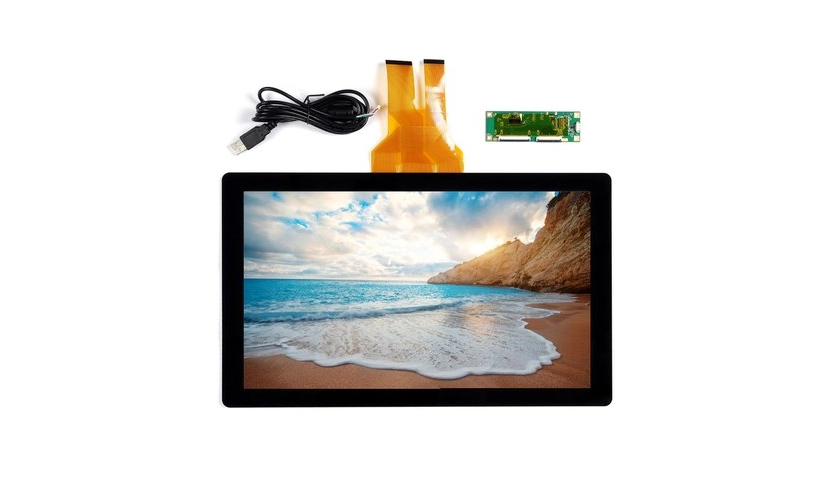Views: 265 Author: Vickey Publish Time: 2024-04-11 Origin: Site









In today's digital age, capacitive touch screens have become ubiquitous, integrated into smartphones, tablets, laptops, and various other electronic devices. Their responsiveness, accuracy, and intuitive interface have revolutionized the way we interact with technology. But have you ever wondered how these touch screens actually work? In this comprehensive guide, we'll delve into the inner workings of capacitive touch screens, exploring the underlying principles and technologies that enable their functionality.
Capacitive touch screens rely on the electrical properties of the human body to detect touch input. Unlike resistive touch screens, which use pressure to register touch, capacitive touch screens detect changes in electrical charge when a conductive object, such as a finger, comes into contact with the screen's surface. This innovative technology enables precise and multi-touch input, making capacitive touch screens ideal for a wide range of applications, from smartphones and tablets to interactive kiosks and digital signage.
Before diving into how capacitive touch screens work, it's essential to understand the concept of capacitance. Capacitance is the ability of a system to store electrical charge. In a capacitive touch screen, the screen itself acts as a capacitor, capable of storing and holding electrical charge.
●Capacitive touch screens consist of multiple layers, each playing a crucial role in their functionality. The primary layers include:
Cover Glass: The outermost layer of the touch screen, responsible for protecting the underlying components from damage and providing a smooth surface for touch input.
●Conductive Layer: Located beneath the cover glass, this layer contains a grid of conductive material, typically indium tin oxide (ITO). The conductive layer forms the sensing surface of the touch screen and detects changes in electrical charge.
●Dielectric Layer: Positioned between the conductive layer and the display panel, the dielectric layer insulates the conductive layer from the display panel and helps maintain the capacitance of the touch screen.
●Display Panel: The underlying display panel, which may be LCD (Liquid Crystal Display) or OLED (Organic Light-Emitting Diode), presents the visual output of the device.

Capacitive touch screens employ two main methods to detect touch input: mutual capacitance and self-capacitance.
●Mutual Capacitance: In mutual capacitance, the touch screen's conductive layer is divided into rows and columns, creating a grid-like structure. When a finger touches the screen, it creates a conductive path between specific rows and columns, causing a change in capacitance at that intersection. By measuring these changes in capacitance, the touch screen can determine the precise location of the touch.
●Self-Capacitance: In self-capacitance, the touch screen's conductive layer forms a single continuous surface. When a finger touches the screen, it alters the capacitance of the entire surface. By analyzing these changes in capacitance, the touch screen can determine the position and size of the touch.
Capacitive touch screens offer several advantages over other touch screen technologies, including:
●High Sensitivity: Capacitive touch screens are highly sensitive to touch input, allowing for precise and accurate interaction.
●Multi-Touch Support: Capacitive touch screens can detect multiple points of contact simultaneously, enabling gestures such as pinch-to-zoom and two-finger scrolling.
●Durability: With no moving parts, capacitive touch screens are more durable and resistant to wear and tear compared to resistive touch screens.
●Clarity and Brightness: Capacitive touch screens can be combined with high-quality LCD displays, resulting in vibrant colors, sharp images, and excellent visibility even in bright lighting conditions.
LCD (Liquid Crystal Display) technology is commonly used in conjunction with capacitive touch screens to create high-quality visual displays with responsive touch capabilities. LCD displays utilize liquid crystal molecules to modulate light and produce images with remarkable clarity and precision.
By integrating capacitive touch screens with LCD displays, manufacturers can create sleek and sophisticated devices with intuitive touch interfaces. Whether it's a smartphone, tablet, or interactive kiosk, the combination of capacitive touch screens and LCD displays offers users a seamless and engaging experience.
Capacitive touch screens have transformed the way we interact with technology, offering a responsive, intuitive, and immersive user experience. By leveraging the electrical properties of the human body, capacitive touch screens can detect touch input with unparalleled accuracy and sensitivity. Whether it's navigating a smartphone, playing games on a tablet, or interacting with interactive displays, capacitive touch screens have become an integral part of our daily lives.
As technology continues to evolve, capacitive touch screens will likely play an even more significant role in shaping the future of human-computer interaction. With their versatility, durability, and responsiveness, capacitive touch screens are poised to remain at the forefront of touch screen technology for years to come.
What are the steps in the manufacturing process of HDMI touch screen?
Analysis of the Causes of Faults in 2.4 Capacitive Touch Screens
What Are Projected Capacitive Touch Screens and How Do They Work?
How Do You Replace a Resistive Touch Screen When It Stops Working?
What Are the Considerations When Integrating Capacitive Touch Screens Into Your System?
A summary of the touch screen all-in-one machine's application field